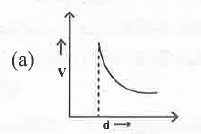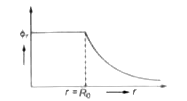ஒரு உள்ளீடற்ற உருளை வடிவ தகட்டின் மின்னழுத்தம் V, தொலைவு (r) ஐப் பொறுத்து மையத்திலிருந்து மாறுகிறது. இதற்கான வரைபடம். [Vஉள்ளே=Q4πε0Rr≤R,Vவெளியே=Q4πε0rr≥R,Vα1r]




The correct Answer is:B
Topper's Solved these Questions
Similar Questions
ஒரு சிலிக்கான் டையோடின் மின்னழுத்த அரண் [தோராயமாக].
View SolutionIf (x+2) is a common factor of (px^(2)+qx+r) and (qx^(2)+px+r) then a p=q or p+q+r=0 b p=r or p+q+r=0 c) q=r or p+q+r=0 d p=q=-(1)/(2)r
View SolutionIf p, q, r are not in G.P. and ∣∣ ∣ ∣∣1qpα+qp1rpα+rqpα+qqα+r0∣∣ ∣ ∣∣=0 Show that pα2+2qα+r=0
View Solutionसारणिक के प्रगुण का प्रयोग कर दिखाइए :
∣∣ ∣ ∣∣0p−qp−rq−p0q−rr−pr−q0∣∣ ∣ ∣∣=0
View Solution|(0,p-q,p-r),(q-p,0,q-r),(r-p,r-q,0)|=
View Solutionसारणिक ∣∣ ∣ ∣∣0p−qp−rq−p0q−rr−pr−q0∣∣ ∣ ∣∣ का मान ज्ञात कीजिए |
View SolutionA nonconducting sphere has radius R = 2.31 cm and uniformly distributed charge q = +3.50 fC. Take the electric potential at the sphere's center to be V_0= 0 . What is V at radial distance (a) r = 1.45 cm and (b) r = R. ( c) If, instead, V_(0)=0 at infinity, what is V at r= R ?
View Solutionविद्युत क्षेत्र की तीव्रता का मात्रक एवं विमा लिखिए
View SolutionAs shown in the figure, the symmetrical spherical body is at the origin, its constant electric potential. (phi_(r)) has given. phi _(r) = (q)/(4pi epsi _(0)) (r ge R _(0)) And phi_(r) =(q)/(4pi epsi _(0) R_(0)) (r le R _(0)) Then the following statement will be false.
View Solutionसममित गोलीय आवेश वितरण के लिए वैद्युत विभव का केन्द्र से दूरी के साथ परिवर्तन चित्र में प्रदर्शित है। दिया है ϕr=q4πε0r,(r≥R0) के लिए ϕr=q4πε0r,(r≤R0) के लिए कौन-से विकल्प सही है?

View Solutionरेखीय (p−q)x+(q−r)y+(r−p)=0
(q−r)x+(r−p)y+(p−q)=0
व (r−p)x+(p−q)y+(q−r)=0 है
View SolutionThe lines (p-q)x+(q-r)y+(r-p)=0(q-r)x+(r-p)y+(p-q)=0 (r-p)x+(p-q)y+(q-r)=0
View Solution[[ 0 , p-q , p-r ],[q-p , 0 , q-r],[ r-p , r-q , 0 ]] =
View SolutionIf p,q,r are not in geometric progression and ∣∣ ∣ ∣∣1qpα+qp1rqα+rqpα+qqα+r0∣∣ ∣ ∣∣=0 then prove that pα2+2qα2+r=0
View SolutionWhich of the following is not equivalent to (p∧~q)→r
(a) ~(qv~p)→r
(b) ~r→(~pvq)
(c)~((p∧(~q))∧(~r))
(d) ~r→(~p∧q)
View Solution
